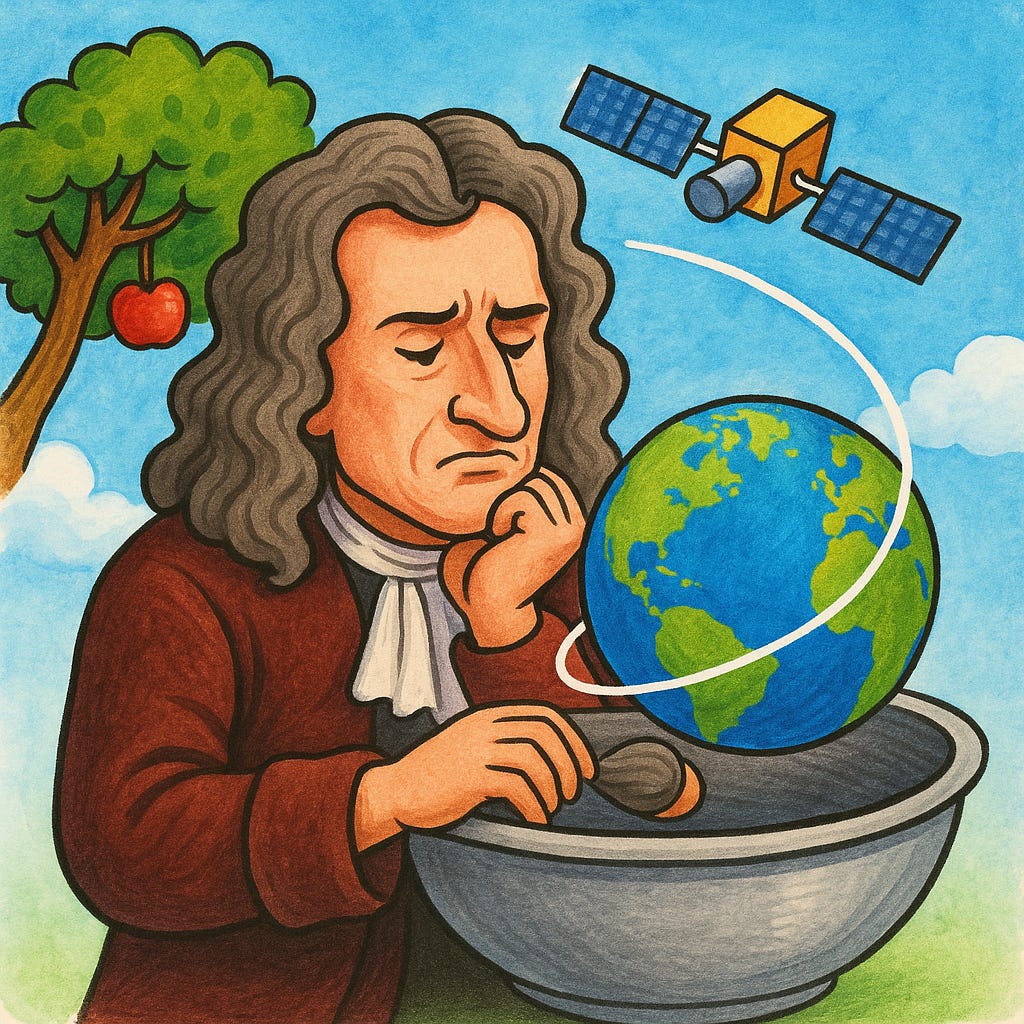Why Do Satellites Not Fall Down or Fly Away?
The Wonder
Look up on a clear night and you might spot a satellite gliding across the sky like a steady, silent star. It's been up there for years, maybe decades, just... floating? But wait - everything falls down. Drop your phone, it hits the floor. Throw a ball, it comes back down. So why do satellites seem to break the universal rule that what goes up must come down? And if they've somehow escaped gravity, why don't they just drift away into space?
The Surface Answer
Many people imagine satellites hovering in place, perhaps held up by constant rocket thrust or floating in a "zero gravity" zone beyond Earth's reach. Others picture them as somehow perfectly balanced between Earth's pull and space's emptiness. But the truth is beautifully counter-intuitive: satellites are falling. They've been falling since the moment they were launched. They just keep missing the Earth.
The Real Reason
Imagine firing a cannonball from a mountaintop. Shoot it slowly, it arcs down and hits the ground nearby. Fire it faster, it travels farther before landing. But here's Newton's genius insight: shoot it fast enough - about 17,500 mph - and something magical happens. The cannonball still falls toward Earth, but Earth's surface curves away at the same rate. The cannonball is falling around the planet.
That's exactly what satellites do. They're in constant free fall, but moving sideways so fast that Earth's curve matches their fall. It's like being on the universe's most extreme roller coaster - you're always plummeting but never hit bottom because the track keeps curving away beneath you.
The physics is elegantly simple: gravity provides the exact centripetal force needed to keep the satellite curving around Earth at that speed. Too slow, and gravity wins - the satellite spirals down. Too fast, and it overshoots into a higher orbit or escapes entirely.
The Evolution
Humans dreamed of this for centuries, but the math came first. Newton worked out orbital mechanics in 1687, nearly 300 years before we could test it. He literally invented calculus to solve this problem. Jules Verne imagined it in fiction. But it took the Cold War to make it real.
Sputnik in 1957 proved Newton right. That beeping basketball-sized sphere stayed up for three months before atmospheric drag finally won. Each subsequent satellite pushed higher, lasted longer. We learned that at 22,236 miles up, a satellite orbits once every 24 hours - matching Earth's rotation perfectly. These "geostationary" satellites seem to hover over one spot, ideal for communications and weather monitoring.
The Benefits
This perpetual fall gives us almost everything modern. GPS satellites fall around Earth twice daily, their precise timing enabling navigation. Weather satellites fall in polar orbits, scanning the entire planet. Communication satellites in geostationary orbits bounce our calls and internet traffic across continents. The International Space Station falls around Earth every 90 minutes with humans aboard.
The beauty is it's nearly free. Once you've invested the energy to reach orbital velocity, physics does the rest. No fuel needed to stay up - just to occasionally correct for the tiny drag from Earth's extended atmosphere or gravitational irregularities.
The Alternatives
Why not just hover using rockets? The fuel requirements would be astronomical. A typical satellite would burn through its entire mass in minutes trying to hover. Why not use balloons? They can't get high enough - the atmosphere thins out long before orbital altitudes.
Some satellites do actively maintain position - "station keeping" for geostationary satellites uses tiny thrusters. But they're just fine-tuning the natural orbital mechanics, not fighting gravity. And yes, satellites in low orbit do eventually fall. The ISS would reenter Earth's atmosphere in about a year without periodic boosts.
The Satisfaction
So satellites don't defy gravity at all. They've simply turned falling into an art form - an endless plummet that never reaches the ground. Every satellite is a thrown stone that never lands, a testament to the beautiful way physics can turn apparent impossibilities into everyday realities. They're not floating, hovering, or escaping. They're falling with style, forever missing the ground in a carefully choreographed dance with gravity. And that dance powers our modern world, from the GPS in your pocket to the weather forecast on your phone - all thanks to objects in perpetual fall.


